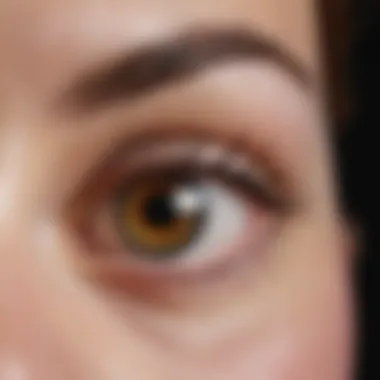Nystagmus and Contact Lenses: Solutions and Impacts


Intro
Nystagmus is a complex visual disorder marked by involuntary eye movements. This condition can lead to significant disruption in visual acuity and spatial orientation. Individuals who experience nystagmus face unique challenges in their daily lives, particularly when it comes to vision correction. Contact lenses, as a prevalent form of vision correction, hold a potential solution for this demographic.
There is a need to better understand how contact lenses can assist individuals with nystagmus. This understanding encompasses both the innovative aspects of modern lenses and the implications for those affected by this condition. The following sections will explore key findings, objectives of research, and ultimately provide insight into the relationship between nystagmus and contact lenses.
Prelims to Nystagmus
Nystagmus is a complex and often debilitating condition that impacts many individuals around the world. Understanding this condition is crucial, not only for healthcare professionals but also for educators, researchers, and affected individuals. The discussion surrounding nystagmus and its implications on vision can shed light on challenges related to daily activities and the overall quality of life.
In this section, we will explore the definition, types, and prevalence of nystagmus, serving as a foundational understanding for the subsequent sections focusing on contact lenses as a solution. Gaining insights into nystagmus is key to addressing the needs of those affected, as well as enhancing the development of innovative solutions like contact lenses.
Definition of Nystagmus
Nystagmus refers to involuntary eye movements, which can be rapid and oscillating. This condition may appear as a side-to-side motion, up-and-down motion, or even circular movements. The eye movements are typically a result of issues within the vestibular system, the visual system, or the cerebellum, disrupting normal vision. Understanding this definition is important, as it establishes the basis for evaluating strategies to mitigate the effects of nystagmus through various interventions, including contact lenses.
Types of Nystagmus
There are several types of nystagmus, each characterized by specific features and underlying causes.
- Congenital Nystagmus: Usually present at birth or develops in infancy. This type often remains stable over time.
- Acquired Nystagmus: Develops later in life due to various factors such as neurological conditions, medication side effects, or alcohol consumption.
- Manifest Nystagmus: Present during fixation and is visible to others.
- Latent Nystagmus: Only observable when one eye is covered, revealing the dependency of the brain on both eyes for stable vision.
Understanding these distinctions is vital, as it influences how professionals approach treatment and intervention methods.
Prevalence and Demographics
Nystagmus is more common than many may assume, affecting an estimated 1 in 1,000 individuals. The prevalence can vary based on genetic factors or early childhood conditions.
- Age: Congenital nystagmus often manifests during early childhood, while acquired forms may emerge at any age.
- Gender: Some studies indicate a slightly higher prevalence in males compared to females.
- Geographic Variation: Certain regions may report higher incidences due to genetic conditions prevalent in those populations.
In essence, understanding the demographics is key to tailoring interventions and support systems for affected individuals and their families, ensuring that solutions meet diverse needs.
Understanding Contact Lenses
Understanding the nuances of contact lenses is essential in the context of managing nystagmus. This vision condition presents unique challenges that can significantly influence the choice and effectiveness of corrective lenses.
Contact lenses can provide several benefits to individuals with nystagmus. They can enhance vision clarity and support proper alignment of vision, which is critical given the involuntary eye movements associated with nystagmus. Furthermore, contact lenses sit directly on the eye, reducing the distortions that eyeglasses might introduce. The importance of this choice becomes evident when considering how glasses can exacerbate blurred vision or issues of focus for those experiencing nystagmus.
Some factors must also be considered when discussing contact lenses. Fitting and adapting to contact lenses can vary significantly among patients; thus, ongoing support and assessment from eye care professionals are crucial. Patients may face adaptation difficulties that can affect their compliance with contact lens wear. Addressing these aspects can lead to better outcomes in vision management.
Types of Contact Lenses
Contact lenses come in different types, each tailored for various conditions and vision correction needs. Common types include:
- Soft contact lenses: These are flexible and comfortable, which can be beneficial for those with nystagmus due to their adaptability and comfort during wear.
- Rigid Gas Permeable (RGP) lenses: These lenses provide excellent vision correction and are more durable than soft lenses. They can also be customized for specific vision needs.
- Toric lenses: Designed for individuals with astigmatism, toric lenses help correct irregularities in the cornea.
- Multifocal lenses: These lenses can address presbyopia, allowing individuals to see clearly at various distances. Each type has its own advantages and drawbacks, which must be evaluated with a healthcare provider.
Developments in Contact Lens Technology
Recent advancements in contact lens technology have transformed how individuals with nystagmus experience vision correction. Innovations such as digital manufacturing methods have improved the precision in lens fitting. Furthermore, materials used in contact lenses have evolved to enhance breathability and comfort. Newer lenses can now offer moisture retention to minimize dryness, a common concern for lens wearers.


Moreover, customizable options are increasingly available, allowing for specialized lenses that accommodate specific eye conditions like nystagmus. Enhanced designs aim to reduce motion blur and improve stability on the eye, forming a closer fit that enhances visual quality. Emerging technologies, such as smart lenses, hold potential for even greater developments in the future.
Application of Contact Lenses in Vision Correction
The application of contact lenses extends beyond basic vision correction. For those with nystagmus, well-fitted lenses can lead to significant improvements in quality of life. Properly selected contact lenses enable better integration of visual input, which is critical for daily activities.
Studies suggest that contact lenses may aid in reducing the frequency or intensity of oscillopsia, the perception of movement in the visual field due to nystagmus. With custom solutions, like specialized lens designs, individuals can experience a more stable image, reducing visual disturbances.
Ultimately, contact lenses are not merely a corrective tool; they can be an integral aspect of a patient's daily function and social interaction. Considering all these facets can lead to significant improvements in the management of nystagmus and overall satisfaction with vision correction methods.
The Impact of Nystagmus on Vision
Nystagmus significantly affects visual perception for individuals. This condition can lead to various challenges, influencing both daily experiences and overall well-being. Understanding how nystagmus impacts vision is fundamental to appreciating the role of contact lenses in mitigating these effects. This section examines the disturbances associated with nystagmus, the functional limitations individuals face, and the psychosocial repercussions that may arise. Each aspect offers insight into the multifaceted experience of living with this condition.
Visual Disturbances Associated with Nystagmus
Individuals with nystagmus often encounter distinct visual disturbances. The involuntary eye movements can result in blurriness and difficulty focusing. These fluctuations in visual clarity can impede observation of fine details, making activities like reading or recognizing faces challenging. Furthermore, the rapid and uncontrollable movements can lead to oscillopsia, where objects appear to move or sway, contributing to visual discomfort. Those affected may also struggle with depth perception, which can hinder activities such as driving or playing sports.
"The unpredictable nature of nystagmus can turn a simple visual task into a complex ordeal."
Understanding these disturbances is crucial for developing effective solutions. Contact lenses aimed at stabilizing vision can assist by reducing optical distortions caused by the eye's motion. Thus, it is essential to grasp the specific visual challenges nystagmus presents to implement tailored corrective measures effectively.
Functional Limitations in Daily Activities
The functional limitations tied to nystagmus can pervade daily life. Activities that require precise vision may become sources of frustration. For example, in educational settings, students may struggle to follow along in class or see the board clearly. Tasks such as cooking or sewing, which require attention to detail, can become daunting. These practical challenges often inhibit independence. Individuals may rely on assistive devices or seek assistance, which can be disheartening.
Moreover, the inability to focus can hinder professional endeavors. Jobs demanding high levels of visual precision, such as graphic design or surgery, may be particularly challenging. The stress of navigating these limitations can lead to avoidance behaviors, further impacting quality of life and personal ambition.
Psychosocial Effects of Nystagmus
Psychosocially, the implications of nystagmus can be profound. The visible aspects of the condition may bring about social stigma or misunderstanding. Individuals may feel self-conscious about their eye movements, leading to anxiety in social situations. Being unable to engage effectively during conversations can contribute to feelings of isolation and frustration.
Additionally, the emotional burden stemming from frustrations related to vision can affect mental health. Issues such as depression or low self-esteem can arise in response to the limitations imposed by nystagmus. Support systems, such as community groups or counseling, can mitigate some of these effects by providing social connections and shared experiences.
In summary, nystagmus affects individuals beyond just vision. The visual disturbances, functional limitations, and psychosocial effects intertwine, creating a complex experience. Understanding these aspects is vital for clinicians and practitioners, ultimately guiding the effective use of contact lenses and other solutions.
Contact Lenses as a Solution for Nystagmus
Contact lenses have become a significant solution for individuals living with nystagmus. This condition, involving involuntary eye movements, affects one's ability to achieve stable vision. By utilizing contact lenses, patients can experience enhanced visual stability. This article section will discuss the underlying mechanisms of actions of these lenses, their potential benefits, and provide real-world case studies demonstrating their efficacy.
Mechanism of Action
Contact lenses are designed to correct vision in a way that accommodates the unique challenges posed by nystagmus. When worn, these lenses sit directly on the eye's surface. This position allows them to become part of the optical system, reducing the impact of erratic eye movements.
The mechanism of action can be summarized in a few key points:
- Stabilization of Visual Acuity: Contact lenses help maintain a clear image on the retina, even when eye movements are involuntary and unpredictable.
- Minimizing Distortion: Unlike glasses, which can be affected by the distance between the lens and the eye, contact lenses minimize visual distortion by maintaining a consistent distance.
- Improved Peripheral Vision: These lenses can provide a wider field of view, making it easier for individuals with nystagmus to navigate their environment.


Potential Benefits of Contact Lenses
The potential benefits of contact lenses for patients with nystagmus are varied and significant. Some of the key advantages include:
- Greater Comfort: Many patients find contact lenses more comfortable than glasses, especially during physical activities.
- Enhanced Aesthetic Appeal: Contacts allow individuals to maintain a natural appearance, which can be psychologically beneficial for those self-conscious about wearing glasses.
- Increased Mobility: With better peripheral vision and less distortion, contact lens users often feel more confident in movement, contributing to a better quality of life.
- Customization Options: Special types of lenses, such as toric or scleral lenses, can be tailored to meet the specific visual needs of patients with nystagmus.
"The application of contact lenses in managing nystagmus has shifted perceptions, making daily life more manageable for many."
Case Studies and Clinical Evidence
Clinical evidence supporting the use of contact lenses for nystagmus patients is growing. Several studies illustrate the impact of these lenses on vision quality and day-to-day functioning:
- Study 1: A clinical trial demonstrated that participants using specialized contact lenses reported a 30% improvement in visual clarity compared to those who only used glasses.
- Study 2: Another study highlighted that individuals with nystagmus who transitioned to contact lenses experienced a significant reduction in visual fatigue during prolonged tasks.
- Case Example: One patient, after switching from glasses to scleral lenses, noted remarkable improvements in reading and driving, highlighting increased confidence and safety.
These findings emphasize the significant role contact lenses can play in managing the symptoms of nystagmus. As research evolves, the potential for more innovative solutions also grows.
Challenges and Considerations
Understanding the challenges and considerations related to contact lens use for individuals with nystagmus is crucial for both patients and practitioners. These challenges can significantly affect the overall success of vision correction strategies. Nystagmus itself introduces complexities in how a person perceives the world, which can consequently influence contact lens adaptation, health, and accessibility. Addressing these factors allows for a more informed approach to managing nystagmus through compliant and effective solutions.
Adaptation Difficulties with Contact Lenses
Adapting to contact lenses can be particularly difficult for individuals with nystagmus. The involuntary eye movements associated with this condition can make it hard for users to stabilize their vision. Some patients may find it challenging to keep the lenses in the correct position on the eye, especially if their nystagmus results in excessive movements. Factors such as lens type, fit, and prescription can play substantial roles in adaptation.
The process may require extensive practice to achieve comfort and clarity. Eye care professionals should patiently guide patients through this adaptation process, offering tips and reassurance. An essential first step is a thorough examination to determine the most suitable type of lens, whether soft or hard, and addressing any concerns about discomfort. The support from eye care specialists encourages the perseverance necessary for adjustment.
Risk of Complications and Side Effects
Using contact lenses comes with inherent risks. Individuals with nystagmus may face specific complications such as lens displacement or irritation. Since nystagmus may cause increased eye movement, the lenses can easily shift out of alignment — leading to discomfort or blurry vision.
Additionally, prolonged use of contact lenses can heighten the risk of corneal abrasions, infections, or allergic reactions. Regular monitoring by an eye care professional is essential. Patients should also receive education about proper hygiene practices and handling techniques to minimize risks. Creating a proactive approach to managing these complications is vital for successful long-term use of contact lenses.
Cost and Accessibility Issues
Cost is a prominent factor that can limit access to contact lenses for some individuals with nystagmus. Contact lenses, especially specialized ones, may not be covered by insurance. The financial burden can deter patients from pursuing this vision correction method.
Furthermore, accessibility to qualified eye care providers who understand nystagmus is sometimes limited. Patients in rural areas may struggle to find practitioners with experience in prescribing and fitting contact lenses for this specific condition.
Efforts must be taken to improve educational resources and expand access to affordable vision care options to ensure more individuals can benefit from contact lenses. It is important to advocate for policies that promote affordability and accessibility in ocular health services.
Understanding these challenges ensures that individuals with nystagmus receive effective support from practitioners and can make informed decisions regarding their vision correction options.
Future Directions in Research
Research into nystagmus and contact lenses is essential for several reasons. First, advancing our understanding of nystagmus can have meaningful implications for how individuals interact with the world. As we explore innovative solutions such as specialized contact lenses, we can address existing challenges faced by patients and improve their quality of life. These directions not only focus on breakthroughs in lens technology but also consider long-term outcomes and incorporate modern healthcare methods like telemedicine.
Innovations in Lens Design


Innovations in lens design play a pivotal role in improving the functionality of contact lenses. Recent advancements focus on customization. Tailored systems can account for the different types and degrees of nystagmus. Innovations include the use of adaptive optics, which aim to adjust the lens curvature based on eye movements. This may help in stabilizing the visual image during involuntary motions. Furthermore, researchers are studying materials that can enhance tear film stability, providing comfort for prolonged wear. This means that innovation is not only about clarity of vision but also about maintaining a comfortable experience.
Investigating Long-Term Outcomes
The investigation of long-term outcomes is crucial in understanding the efficacy of contact lenses for nystagmus patients. Researchers need to study how consistent use affects vision and daily life over time. Advantages can include an increased level of comfort and adaptability with regular wear. However, it is also vital to identify risks that may emerge from long-term use. Regular assessments will help ensure that the lenses continue to meet the visual needs of patients. By focusing on longitudinal studies, healthcare professionals can formulate guidelines tailored to each individual’s requirements.
Potential Role of Telemedicine
Telemedicine has become more relevant, especially during recent health crises. It serves as a platform for managing eye care remotely. This approach allows for consultations with specialists who can monitor nystagmus patients effectively. Patients can receive customized advice on contact lens usage without the need for frequent clinic visits. Additionally, telemedicine facilitates tracking changes in visual acuity over time. This can lead to quicker adjustments in lens specifications based on patient feedback.
"The incorporation of telemedicine creates a seamless connection between patients and eye care professionals, enhancing adaptability and ensuring focused care."
Exploring these future directions promotes a broader understanding of nystagmus management. Encouraging ongoing research allows the health community to innovate continuously, ensuring that those affected by the condition can benefit from ever-improving solutions. The merger of reliable lens design, comprehensive outcome studies, and telemedicine support reinforces the potential for positive changes in patients' lives.
Patient Perspectives
The perspectives of patients with nystagmus are vital to understanding the true impact of this condition and the effectiveness of contact lenses as a treatment. Patient experiences provide invaluable insights into the daily challenges they face and how they perceive the benefits of vision correction solutions. This section emphasizes the need to elevate the voices of those affected, acknowledging their unique situations and describing how they manage the complexities of nystagmus. Evaluating individual experiences enriches our understanding of the broader implications of this condition and informs practitioners about real-life outcomes associated with specific interventions, like contact lenses.
Personal Experiences with Nystagmus
Individuals living with nystagmus frequently describe their experiences as a mixture of challenges and adaptations. Many report difficulties in visual tasks such as reading or driving. These challenges often lead to frustration and, at times, social isolation. For instance, Janet, a 32-year-old woman, explains that her condition makes it hard for her to focus on labels in grocery stores. She has learned to rely on familiarity with products, which alleviates some stress. Yet, navigating new environments remains a challenge.
Another patient, Mark, emphasizes the unpredictability of nystagmus episodes. He describes moments where his vision blurs unexpectedly, making it hard to carry out simple tasks. Such personal accounts illustrate the daily struggle many individuals face, which may not be evident in clinical settings. These narratives are indispensable for shaping strategies that cater more effectively to patients' needs.
Patient Testimonials on Contact Lens Use
Testimonials from patients who have used contact lenses for managing nystagmus often highlight both successes and areas of concern. Many patients report significant improvements in their vision quality when using specialized lenses. For Emily, who has worn lenses for two years, the difference was transformative. "I could finally see clearly without the constant movement of my eyes interfering. I felt more confident in social settings," she shares. Such improvement can lead to greater independence and a better quality of life.
However, testimonials also reveal adaptations periods. Some users mention initial discomfort or challenges in keeping the lenses stable. Jake, who started using contact lenses recently, told us that getting used to them required patience. He adds, "Once I understood how to take care of them properly, they became a part of my routine." This duality in testimonials emphasizes the need for thorough education on lens usage and realistic expectations for new users.
Support Systems and Resources
Recognizing the emotional and practical support systems available for patients with nystagmus is critical. Support can take various forms, such as peer groups, professional counseling, and access to eye care specialists. Online communities, including platforms like Reddit, can be excellent resources for patients seeking connection with others who share similar experiences. These forums often provide a space for individuals to discuss tips, share stories, and offer encouragement.
Additionally, educational resources can aid in empowering patients. Organizations focused on vision health often publish material about nystagmus and its management. Websites such as American Academy of Ophthalmology offer guidance and information that can help patients make informed decisions about their treatment options.
In summary, patient perspectives offer a profound understanding of the challenges and solutions faced by individuals with nystagmus. Personal experiences enrich the narrative around this condition, while testimonials drawn from the use of contact lenses provide a nuanced view of outcomes. Moreover, recognizing support systems available to patients creates a more robust framework for addressing their needs.
Closure
The conclusion serves a vital role in synthesizing the extensive information presented in this article. Nystagmus is a complex condition with significant impacts on visual function and life quality. Understanding its relationship with contact lenses opens avenues for practical solutions.
Summary of Key Findings
Nystagmus primarily affects involuntary eye movement which leads to challenges in vision clarity. Research indicates that specialized contact lenses can provide crucial support in enhancing visual performance. These lenses help stabilize vision and can mitigate the disruption caused by nystagmus. Findings show improved daily functionality with regular use of appropriate contact lenses. The development of new technologies in lens design has transformed options available for those with this condition.
Implications for Patients and Practitioners
For patients, the insights gained from this article underscore the need for individualized care in managing nystagmus. Practitioners must focus on recommending specific types of contact lenses that meet unique patient needs. This can improve adherence to prescribed treatments and positively influence patient satisfaction. Hence, both patients and healthcare professionals should be aware of the advancements in contact lens technology and the strategies for effective visual correction.
Call for Continued Research and Innovation
Research in the realm of nystagmus and its management through contact lenses must persist. Ongoing investigations into lens efficacy and long-term outcomes will benefit future patients. Exploring telemedicine for consultation on contact lens adaptation could also expand access to care. Ultimately, continued innovation in lens technology could further enhance the quality of life for individuals affected by nystagmus.
A comprehensive understanding of nystagmus and contact lenses lays the foundation for improved treatment strategies and patient outcomes.







